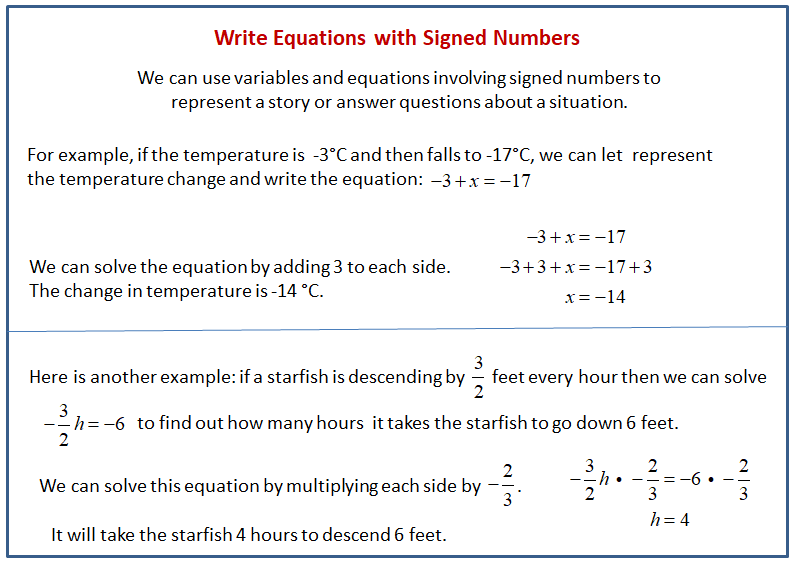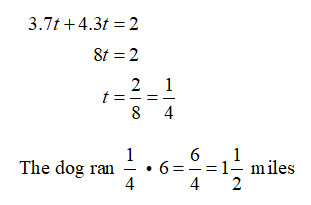Illustrative Mathematics Grade 7, Unit 5, Lesson 16: Representing Contexts with Equations
Learning Targets:
- I can explain what the solution to an equation means for the situation.
- I can write and solve equations to represent situations that involve rational numbers.
Related Pages
Illustrative Math
Grade 7
Lesson 16: Representing Contexts with Equations
Let’s write equations that represent situations.
Illustrative Math Unit 7.5, Lesson 16 (printable worksheets)
Lesson 16 Summary
The following diagram shows how to write and solve equations to represent situations that involve rational numbers.

Lesson 16.1 Don’t Solve It
Is the solution positive or negative?
(-8.7)(1.4) = a
-8.7b = 1.4
-8.7 + c = -1.4
-8.7 - d = -1.4
Lesson 16.2 Warmer or Colder than Before?
For each situation,
- Find two equations that could represent the situation from the bank of equations. (Some equations will not be used.)
- Explain what the variable represents in the situation.
- Determine the value of the variable that makes the equation true, and explain your reasoning.
Bank of equations:
- Between 6 a.m. and noon, the temperature rose 12 degrees Fahrenheit to 4 degrees Fahrenheit.
- At midnight the temperature was -6 degrees. By 4 a.m. the temperature had fallen to -16 degrees.
- The temperature is 0 degrees at midnight and dropping 3 degrees per hour. The temperature is -6 degrees at a certain time.
- The temperature is 0 degrees at midnight and dropping 3 degrees per hour. The temperature is 9 degrees at a certain time.
- The temperature at 9 p.m. is one third the temperature at midnight.
You may use this applet if you find it helpful.
Open Applet
Lesson 16.3 Animals Changing Altitudes
Match each situation with a diagram.
A. A penguin is standing 3 feet above sea level and then dives down 10 feet. What is its depth?
B. A dolphin is swimming 3 feet below sea level and then jumps up 10 feet. What is its height at the top of the jump?
C. A sea turtle is swimming 3 feet below sea level and then dives down 10 feet. What is its depth?
D. An eagle is flying 10 feet above sea level and then dives down to 3 feet above sea level. What was its change in altitude?
E. A pelican is flying 10 feet above sea level and then dives down reaching 3 feet below sea level. What was its change in altitude?
F. A shark is swimming 10 feet below sea level and then swims up reaching 3 feet below sea level. What was its change in depth?
2. Next, write an equation to represent each animal’s situation and answer the question. Be prepared to explain your reasoning.
Penguin
Dolphin
Sea turtle
Eagle
Pelican
Shark
Lesson 16.4 Equations Tell a Story
Your teacher will assign your group one of these situations. Create a visual display about your situation that includes:
- An equation that represents your situation
- What your variable and each term in the equation represent
- How the operations in the equation represent the relationships in the story
- How you use inverses to solve for the unknown quantity
- The solution to your equation
- As a 7 1/4 inch candle burns down, its height decreases 3/4 inch each hour. How many hours does it take for the candle to burn completely?
- On Monday 1/9 of the enrolled students in a school were absent. There were 4,512 students present. How many students are enrolled at the school?
- A hiker begins at sea level and descends 25 feet every minute. How long will it take to get to an elevation of -750 feet?
- Jada practices the violin for the same amount of time every day. On Tuesday she practices for 35 minutes. How much does Jada practice in a week?
- The temperature has been dropping 2 1/2 degrees every hour and the current temperature is -15°F. How many hours ago was the temperature 0°F?
- The population of a school increased by 12%, and now the population is 476. What was the population before the increase?
- During a 5% off sale, Diego pays $74.10 for a new hockey stick. What was the original price?
- A store buys sweaters for $8 and sells them for $26. How many sweaters does the store need to sell to make a profit of $990?
Are you ready for more?
Diego and Elena are 2 miles apart and begin walking towards each other. Diego walks at a rate of 3.7 miles per hour and Elena walks 4.3 miles per hour. While they are walking, Elena’s dog runs back and forth between the two of them, at a rate of 6 miles per hour. Assuming the dog does not lose any time in turning around, how far has the dog run by the time Diego and Elena reach each other?
Lesson 16 Practice Problems
- Match each situation to one of the equations.
A. A whale was diving at a rate of 2 meters per second. How long will it take for the whale to get from the surface of the ocean to an elevation of -12 meters at that rate?
B. A swimmer dove below the surface of the ocean. After 2 minutes, she was 12 meters below the surface. At what rate was she diving?
C. The temperature was -12 degrees Celsius and rose to 2 degrees Celsius. What was the change in temperature?
D. The temperature was 2 degrees Celsius and fell to -12 degrees Celsius. What was the change in temperature? - Starting at noon, the temperature dropped steadily at a rate of 0.8 degrees Celsius every hour.
For each of these situations, write and solve an equation and describe what your variable represents.
a. How many hours did it take for the temperature to decrease by 4.4 degrees Celsius?
b. If the temperature after the 4.4 degree drop was -2.5 degrees Celsius, what was the temperature at noon? - Kiran mixes 3/4 cups of raisins, 1 cup peanuts, and 1/2 cups of chocolate chips to make trail mix. How much of each ingredient would he need to make 10 cups of trail mix? Explain your reasoning.
- Find the value of each expression.
a. 12 +(-10)
b. (-5) - 6
c. (-42) + 17
d. 35 - (-8)
e. (-4 1/2) + 3 - The markings on the number line are evenly spaced. Label the other markings on the number line.
- Kiran drinks 6.4 oz of milk each morning. How many days does it take him to finish a 32 oz container of milk?
a. Write and solve an equation for the situation.
b. What does the variable represent?
The Open Up Resources math curriculum is free to download from the Open Up Resources website and is also available from Illustrative Mathematics.
Try the free Mathway calculator and
problem solver below to practice various math topics. Try the given examples, or type in your own
problem and check your answer with the step-by-step explanations.

We welcome your feedback, comments and questions about this site or page. Please submit your feedback or enquiries via our Feedback page.
